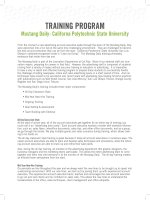DHS Employee Training Plan ( Published: November 2004 Updated: June 2009) potx
Bạn đang xem bản rút gọn của tài liệu. Xem và tải ngay bản đầy đủ của tài liệu tại đây (352.27 KB, 117 trang )
DHS Employee Training Plan
Published: November 2004
Updated: June 2009
Prepared by DHS Training Plan Steering Committee
Table of Contents
SECTION
PAGE
EXECUTIVE SUMMARY 3
INTRODUCTION 6
CURRENT STATE 13
FUTURE STATE 23
Future State Of Employee Training in DHS 24
Principles for DHS Training 26
Roles and Responsibilities 28
Enterprise-Wide Training 31
Learning Teams 33
DHS Management Training 35
Evaluation Criteria, Methods and Recommendations 37
Methodologies: E-Learning/Blended Learning 39
Methodologies: Facilities and Equipment 41
Standards for Design and Delivery 43
Learning Management System 45
MILESTONES 46
BUDGET 51
RISKS AND DEPENDENCIES 54
APPENDIX 56
DHS Employee Training Plan Overview 57
The Essence of Priority Criteria for Sorting Unmet Enterprise Training Needs.61
Resources for Enterprise Wide Training Needs (other than in-house) 68
DHS Enterprise Training Project Overview—August 2004 73
Enterprise-wide Training Needs 75
Learning Teams 76
DHS Management Training 77
DHS Management Mandatory Training Topics Project Overview—July 2004 .78
Management Training Implementation Considerations 82
New Managers 83
All Incumbent Managers 84
Aspiring-To-Be-Managers 85
Sustainable Delivery System 86
Training Evaluation—Report 88
DHS Level 1 Evaluations 89
DHS Level 2 Evaluations 90
DHS Level 3 Evaluations 91
DHS Level 4 Evaluations 92
Standards for Training Design and Delivery 93
E-Learning/Blended Learning: Background 96
E-Learning/Blended Learning: Research Findings 97
E-Learning/Blended Learning: Glossary 98
DHS Training Methodologies—Decision Guidelines 99
Description Of Training By Division 108
FTE Training Percentages by Division 114
Training Plan Updates 115
- 3 -
DHS Employee Training Plan
Executive Summary
- 4 -
DHS Employee Training Plan
Executive Summary
• The DHS Employee Training Plan creates a strategy to align DHS
employee-training resources with its core programmatic and organizational
priorities.
• The plan establishes principles for all employee training in the department.
o Training is linked to the mission, goals and outcomes of DHS.
o It is developed in partnership with the customers requesting and
receiving the training.
o There is a shared delivery system consisting of facilities, learning
technologies, distance learning and instructional design.
o Training is evaluated to determine its effect on intended outcomes.
• The plan outlines the training governance structure.
o It creates a DHS Employee-Training Council to oversee
implementation of the plan and develop strategies for addressing
enterprise-wide training needs, methods and standards for design,
delivery and evaluation.
o It identifies roles and responsibilities for all training entities in the
department.
• The plan identifies enterprise-wide training needs, resources currently
available to address the needs and a process to develop additional training
resources.
• It identifies training currently provided by each division.
• New training and training methods will be developed through the use of
Learning Teams consisting of internal-training customers, subject matter
experts and training-design specialists.
• It includes an outline of the DHS management-training program and a
project plan for implementing the plan beginning in 2004.
o Management training will incorporate the recommendations of the
Workforce Management Committee and the Diversity Development
Coordinating Council (DDCC).
o Mandatory training for all managers will be completed by the end of
2005.
- 5 -
y It creates criteria for training evaluation, including recommendations for
evaluations that may be conducted immediately and for those requiring more
extensive research-design efforts.
• It includes guidelines for decision making concerning training methods, as
well as a process for developing a coordinated system for developing
technology based learning resources, e.g.,e-learning and the Learning
Management System (LMS).
• It creates a means to assure training equipment and facilities are shared
across the enterprise.
• It includes standards for training design and delivery to assure training is
both effectively and efficiently presented.
• It includes milestones for implementation of the plan.
• It identifies line-item budgets and FTE assigned training duties.
• It includes a list of potential risks, which could delay implementation of the
plan.
- 6 -
DHS Employee Training Plan
Introduction
- 7 -
Department of Human Services
Employee Training Plan
The purpose of the DHS Employee Training Plan is to establish a framework for
assuring the department has aligned its employee training resources with its core
programmatic and organizational priorities. Provider training is beyond the scope
of this effort and, therefore, absent from the priorities and resource considerations
in this Training Plan.
The plan identifies training needs, priorities, resources and roles and
responsibilities for all groups engaged in employee training within the department.
It provides a model for governing the training functions within the department,
identifies enterprise-wide training priorities and sets standards for training design,
delivery and evaluation.
BACKGROUND
DHS managers and staff have expressed concerns about the effectiveness of
existing training courses, lack of access to training, confusion about what training
was available, lack of resources to meet unmet needs and a lack of coordination
among the department’s training resources.
There have also been several uncoordinated initiatives concerning the development
of distance learning strategies that had not been addressed from an enterprise-wide
perspective.
In response to these concerns, the DHS Cabinet conducted a survey in Spring 2004
and identified the greatest unmet training needs in each division.
The DHS Training Plan Steering Committee was convened to develop an overall
training plan for the department. It was charged to use the Cabinet’s Training
Needs Survey as a basis for making recommendations on training priorities,
resources, standards for training methods, design and delivery, methods to increase
the coordination of DHS training resources and to evaluate the effectiveness of
investments in employee training.
(See Appendix, first page, DHS Employee Training Plan Overview for the full
description of the DHS Training Plan Steering Committee’s charge.)
- 8 -
The Steering Committee developed the Training Plan using a process that included
gathering data on existing training resources, identifying gaps in needs and
resources and exploring options for enterprise-wide governance and better
alignment of DHS training with organizational and programmatic needs.
The Steering Committee process included:
• creating a governance model for DHS training
• developing principles to guide DHS training decisions and investments
• sorting the Cabinet survey into enterprise-wide and cross-division training
needs, with enterprise needs ranked into high, medium and low priority
• inventorying division training resources, budgets, program and
administrative services training priorities and on-the-job training for
employees
• developing implementation plans for DHS management training based on
decisions by the Workforce Management Steering Committee
• forming decision guidelines on training methodologies
• examining methods and criteria for evaluating DHS training
• exploring the value of adopting standards for training design and delivery
• reviewing the method used to represent training budgets and expenditures
THE TRAINING-PLAN FORMAT
The Training Plan is divided into several sections.
1. Executive Summary
2. Introduction
3. Current State—a description of the current state of training: the way that
training is prioritized, conducted and evaluated in DHS.
4. Future State—recommendations for how employee training in DHS can be
governed, prioritized, conducted and evaluated upon adoption of the
Training Plan. This includes implementation planning for Management
Training and other enterprise-wide training priorities.
5. Budget—a description of the current training budgets.
6. Milestones—key implementation actions, deadlines and responsibilities for
recommendations in the Training Plan.
7. Risks and Dependencies—a list of risks that can impede implementation of
the Training Plan recommendations, sorted into high, medium and low and
with suggestions for mitigating these risks; a list of dependencies among the
Training Plan recommendations.
- 9 -
8. Implementation Considerations—considerations from the Steering
Committee about gaining support for and ensuring success of the Training
Plan recommendations in their respective parts of DHS.
9. Appendix—contains details supporting the Training Plan recommendations
and the inventory of current training resources.
TRAINING PLAN RECOMMENDATIONS
The DHS Training Plan Steering Committee recommends adopting the Training
Plan in whole. The recommendations in the Training Plan are summarized here.
Further discussion of the recommendations is contained in the Future State section
of this report. Details supporting the recommendations are located in the Appendix.
DHS Training Governance Model
DHS adopt a training governance model that is based on overlapping
responsibilities and a shared delivery system.
• An Employee-Training Council made up of high-level managers with
responsibility for prioritizing training needs and allocating resources to meet
the highest needs. The Employee-Training Council establishes standards for
design, delivery and evaluation and is responsible for implementing these in
their division.
• Each division [CAF, SPD, HS and department wide shared services (AS,
FPA and DO)] has responsibility for identifying and prioritizing program/
administrative function training needs and allocating its own resources to
meet the highest needs.
• Each division participates in the identification of enterprise-wide training
needs and contributes resources as necessary.
• Each division shares in a system of department-wide resources for the
delivery of training. This is called a shared delivery system and includes
distance-learning technology (NetLink, video conferencing, video
production, web-based training), Learning Management System,
instructional-design services for subject matter experts, standards for design,
delivery and evaluation.
DHS Training Principles
DHS adopt this set of Training Principles for use by Employee-Training Council
and each division in prioritizing and allocating resources for training.
DHS Management Training
DHS is implementing the decisions of the Workforce Management Steering
Committee for mandatory management training. To support this effort, DHS:
- 10 -
• assign resources for curriculum design teams of subject matter experts, key
customers and staff with training development and evaluation expertise.
• provide on-the-job support for new managers.
Enterprise-Wide Training
DHS adopt the highest enterprise-wide training priorities identified by the Steering
Committee and delegate to the Employee-Training Council responsibility for
allocating resources to meet these needs, identify new, emerging training and
resource needs and for assuring that unmet cross-division program training needs
are addressed.
Learning Teams
DHS adopt the concept of Learning Teams: short term task groups of subject
matter experts, key customers and staff with training expertise assigned by the
Employee-Training Council to design curriculum and delivery strategies.
The following high priorities are recommended for immediate action:
• New Employee Orientation
• Confidentiality
• Customer Service
• Team Building for Team Leaders
• Diversity trainings: Cultural Competency and Managing a Diverse
Workforce (as recommended by DDCC)
Training Evaluation Criteria and Methods
DHS adopt the Kirkpatrick Model of training evaluation over the course of two
years.
• Provide members for a task group of staff with training and research
expertise to determine core evaluation questions and implementation
processes.
• Provide, hire or contract for a resource to gather evaluation data from
throughout DHS, analyze and report to Cabinet on a periodic basis.
Training Methodologies, Facilities and Equipment
DHS adopt the Training Methodologies Decision-Making Guidelines to provide
the basis for decisions on delivery methods.
DHS adopt an expectation for increased use of blended learning strategies that
incorporate e-learning methods into training curriculum. This is for the purpose of
increasing access to training, increasing local delivery, reducing travel and per
- 11 -
diem expenses and reducing loss of productivity when members of the staff are
traveling to/from training.
• Convene an E-Learning Strategy Team to develop department e-learning
implementation strategies.
• Increase sophistication of instructional-design skills by providing training to
the staff with responsibility for increasing blended learning strategies.
• Co-house the Salem-based training technology resources and the staff with
responsibility for e-learning development.
• Develop classroom and computer lab facilities in Salem and regionally.
Standards for Training Design and Delivery
DHS adopt standards for training design and delivery.
• Provide members for an ad-hoc, short-term Learning Team with staff who
have training expertise to develop standards.
• Employee-Training Council responsible for assuring implementation of
standards.
SUMMARY
The DHS Employee Training Plan contains a set of recommendations for approval
by the DHS Cabinet. The Training Plan lays out a governance model for training in
DHS. It identifies the highest enterprise-wide training needs and provides
recommendations for meeting these needs, increasing the coordination of training
resources in DHS and increasing the alignment of training with organizational and
programmatic priorities.
- 12 -
The DHS Employee Training Plan was developed by:
Michael Buckley Self-Sufficiency Programs and Training Services Manager,
Children, Adults and Families
Rich Cook Training Services Manager, Children, Adults and Families
Bill Coulombe Manager of Program Operations, Health Services
Tami Dohrman Administrator of Office of Financial Services Manager,
Administrative Services
Kristen Duus Deputy Chief Information Officer
Judy Gerrard Manager, DHS Training & Development
Deanna Hartwig Acting Administrator, Office of Federal Resource and Financial
Eligibility, Seniors and People with Disabilities
Sue Nelson Administrator, Office of Human Resources
Jim Sehon Chair and former DHS Human Resources Manager
Naomi Steenson Administrator, Governor’s Advocacy Office
John Swanson Deputy Assistant Director, Finance and Policy Analysis
Learning Leadership Council - Training Plan Reports:
Management Training: Ann Croucher, Jeanette Burket, Judy Gerrard, Priscilla
Cuddy and Jim Sehon
Training Evaluation: Cheryl Furrer, Kush Shrestha, Ann Croucher, Judy
Gerrard, Priscilla Cuddy and Jim Sehon
Methodologies: Lisa Harnisch, Linda Kilgore, Shawn Clark, Jim Sehon,
Judy Clyburn, Jennifer DeJong, Rich Cook
Cabinet Survey of
Training Needs: Judy Clyburn, Kim Kelly, Nancy Talbot, Jim Sehon
- 13 -
DHS Employee Training Plan
Current State
- 14 -
Current State of Training
Employee training in DHS is provided through CAF, SPD, HS and Admin
Services. Approximately 66% of the training focuses on program-related
knowledge and skills, with the balance focused on management, computer skills
and other employee skill development. There is no duplication of training topics
from one division to another.
(See Appendix for a listing of training courses by division and training staff
resources.)
GOVERNANCE
Governance of training is the responsibility of each division. There is no shared,
overall department-wide governance of the DHS training function.
The Learning Leadership Council is a cooperative group of training leads from
each division. Since the DHS reorganization in 2000, the group has met on a
regular basis, responded to several department-wide training issues, sharing
resources and delivery responsibilities. The LLC lacks the authority to assess,
prioritize and allocate resources for enterprise-wide training needs. Some members
lack this authority within their division.
PROGRAM-RELATED TRAINING
Employee training in DHS is primarily focused on program-specific topics through
CAF, SPD and HS. CAF and SPD provide training to their staff and others who
perform service delivery functions similar to DHS employees. Training for
employees within HS is generally within the institutions, OMAP, OMHAS and
OIT.
Most program training needs are identified through the requirements of funding
sources. Training needs are also identified through error rate reports, or other needs
assessments with input from employees, managers, or advisory groups. There are
administrative rules related to training for child welfare staff. Other than the Food
Stamp program, there is little cross-division training or needs assessment for
program training.
Examples of program training being provided are:
• CAF provides training on child welfare, self-sufficiency programs and
vocational rehabilitation.
• SPD provides training on programs for seniors and people with disabilities.
- 15 -
• Health Services provides training on medical assistance programs, abuse
investigations and services to residents of the Oregon State Hospital and
Eastern Oregon Psychiatric Center.
In the DHS Training Plan Steering Committee, both CAF and SPD representatives
expressed an inability to meet all the demands for training within their division.
For CAF, a recent reorganization of their training resources and focus on distance
learning is meant to provide additional resources for training and additional access
though web-based training. For SPD, there is little room to expand the resources
available for employee training. SPD’s training budget is based on the number of
FTE in SPD and does not reflect its responsibility to train AAA employees and
other service-delivery partners.
MANAGEMENT TRAINING
There is no formal management-training program in DHS. There are training
classes suitable for managers, such as Essentials of HR Management, Being An
Ethical Leader, Project Management, Contract Administration, etc. None are
mandatory, unless an individual manager has made this requirement for their
leadership team.
CAF SDA’s have local training budgets and contract for management training
based on local needs. Child Welfare, through its PSU partnership, has conducted
“Supervising For Excellence” for the last several years, a program that has a high
level of attendance by their new managers and is highly valued by CAF leadership.
DAS offers a Management Development Series open to state government
employees. It has reduced its tuition fees a great deal in the last year. This series
has limited capacity to train large numbers of employees.
ENTERPRISE-WIDE TRAINING: ADMINISTRATIVE FUNCTIONS AND
OTHER EMPLOYEE TRAINING
AS provides training for department employees on administrative functions,
computer skills, HR and other employee skill areas.
These enterprise-wide training needs are generally identified by AS staff through
customer interactions or requests. Computer training needs are also identified by
upgrades in computer programs or processes. Some training needs are identified
through labor-management groups, such as training on de-escalating conflict
situations. Examples of training on administrative functions and other employee
training:
- 16 -
• OIS provides training on information systems and basic computer skills.
• HR provides training on Human Resource fundamentals.
• Payroll provides training for managers and for new employees on time
keeping and payroll coding.
• Contracts provides training on contract administration.
• DHS Training & Development provides training on skills that improve
employee effectiveness in task groups, or workplace communication.
There are work groups, who, in the course of their tasks, are developing
recommendations for additional enterprise-wide training:
• Workforce Management Steering Committee has recommended a
management training program.
• Diversity Development Coordinating Council has recommended training
on diversity and cultural competency topics.
Several task groups are currently working on enterprise-wide training needs. These
training needs are usually surfaced by central office task groups and brought to
LLC or other leadership for cross-division resourcing. There is no mechanism for
regularly prioritizing or resourcing emerging enterprise-wide training needs. Some
examples are:
• New Employee Orientation
• ADA/OCR compliance
• Information Security
• Reception-Staff Training
ON-THE-JOB TRAINING
On-the-job training is the purview of individual managers. Managers send staff to
external training programs or bring training to their work units based on their
assessment of needs.
There is little linkage between formalized training from central office and transfer
of that training to the workplace. Some line managers have developed their own
workforce development methods, especially for supporting new staff. In CAF,
leadworkers, HSS4s and CETs help coach new case managers and eligibility
workers. In other divisions, new workers generally receive coaching from more
experienced workers.
In CAF, each SDA has a training budget and a local committee or in-house
resource that determines needs and develops training to meet local needs:
• Plan and deliver training to support local program corrective actions.
- 17 -
• Purchase training from outside resources on management development,
case management skills, diversity topics, etc.
• Manage local SDA training budget.
• There is no aggregate of specific local training needs; these specific
needs are unrepresented in the DHS Cabinet Survey of Greatest Training
needs.
STAFFING THE TRAINING FUNCTIONS IN DHS
Some divisions have Training Development Specialists, while others have
combined training responsibilities with other job duties. Most employee training in
DHS is provided by staff with these combined job duties and little training in
design and delivery. There are no standards for design and delivery and no
methods for ensuring that DHS is maximizing the time employees spend in a
training mode.
CAF has made significant changes in the staffing of its training function in the last
10 months: moved training responsibility to policy analysts, increased interest in
distance learning, dissolved the training unit at Winema Place and refocused the
Technical Training Unit on training-delivery support, such as NetLink. CAF has
several internal committees working on program training needs assessment, setting
priorities and allocating internal resources.
DHS Training & Development, housed in AS/Office of HR, provides some
training or training coordination on an enterprise-wide basis. For example:
• Management/Leadership topics
• Information Security
• On-line training registration system
• NetLink
TRAINING DELIVERY METHODS
DHS training methods have relied on traditional face-to-face instruction with
which students and trainers are most comfortable. There is a belief in DHS that
instructor-led classroom training is the “best” training delivery method. There is no
evaluation of current training delivery methods to know that this is always the
case. Current research in the training profession recommends a blended learning
method combining distance learning and self-study with classroom.
Classroom
: Training is primarily delivered in a classroom setting, with some use
of distance learning. Most classroom training is delivered in Salem, some in
Portland, other I-5 corridor locations and occasionally in Eastern or Central
- 18 -
Oregon. CAF/FACIS and OIS deliver computer training in field locations
throughout Oregon. DHS Training & Development delivers several of its classes in
field locations, often in response to requests from managers to bring specific topics
to their local areas.
Distance learning
: NetLink, where presenter and employees are online together, is
the main distance learning method used in DHS. Staff from DHS Training &
Development, CAF, SPD, HS and OIS were trained by the vendor in the use of
NetLink and are helping to train others.
DHS Training & Development provides NetLink system administration, technical
support, training of presenters and studio production for all department customers.
In the last several months, CAF has created a NetLink studio at the Cherry Avenue
location and is providing studio services for CAF staff.
There is interest in DHS for developing web-based, self-paced training: CAF, OIS,
upcoming management training, new employee orientation. Staff in OIS and DHS
Training & Development have some limited experience in this methodology.
Video production
: DHS Training & Development provides video production
services for a small number of requests throughout the year, such as New
Employee Orientation; and also loans video equipment to internal customers for
taping training sessions for use within a division. CAF plans to provide video
production services for CAF training needs. Occasionally, ODOT or other video
production services from outside DHS are used.
Video conference
: DHS is in the process of evaluating the use of the DAS video
conferencing network.
TRAINING EVALUATION
Most training has an evaluation component, usually a “satisfaction” rating by the
trainee. Some divisions conduct follow-up evaluations to determine what is
working and what needs improvement. Some pre- and post-tests are used. There is
very little electronic support for evaluation.
There is no reporting of training evaluations; no assessment of whether or not
training is achieving intended outcomes. The evaluations from one event to
another, one method to another, are inconsistent and lack an ability to assist in
developing benchmarks. Staff members with responsibility for training have little
education in testing, research or evaluation methods.
- 19 -
DHS TRAINING WEB PAGE AND ONLINE TRAINING REGISTRATION
SYSTEM
DHS uses www.dhs.state.or.us/training
as the DHS learning portal: one consistent
place for everyone for training information and registration. DHS has an unwritten
policy requiring any training-related information and material to be posted to the
DHS training web page. DHS Training & Development has content management
responsibility; OIS provides the web-master for this web portal.
The Online Training Registration System (OLTRS) is accessed through the web
page. Since 2000, DHS has an unwritten policy that training registration will be
through this system. However, HS/PSOB, HS/OMAP and OVRS maintain separate
training registration mechanisms. Staff, in DHS, with training as part of their job
duties may be unaware of the requirement to document training registration and
attendance through the OLTRS.
DHS Training & Development provides customer service for DHS staff needing to
post training sessions to the system, announce training sessions to DHS Universe
and for staff having difficulty in registering for training. OIS maintains the
database.
The On-line Training Registration System (OLTRS) is being replaced by a
learning management system that will support registration, content-management,
on-line collaboration and e-learning.
TRAINING FACILITIES, ROOMS, EQUIPMENT
The DHS Training Center at Winema Place in Salem was closed due to space
limitations for field staff. This removed several classrooms, shared equipment and
resources from the DHS training community.
Individual rooms are in a myriad of other sites. There is no centralized
coordination; scheduling is on a first come first served basis, accomplished by
calling one location at a time, thus pitting space for training and meetings against
each other.
There are a few computer labs (OIS and CAF offices at Cherry Avenue location;
Discovery Room at Winema location) and in several field offices. LCD projectors,
laptops and other training equipment are located in many places throughout DHS.
There is no centralized coordination or scheduling of these resources. There is no
bank of laptops that can be shared among training staff for regional training
delivery.
- 20 -
TRAINING BUDGETS
Training is budgeted as a line item in each division and expenses are tracked
accordingly. No funds have been budgeted for enterprise-wide training.
(Please see the “Budget” section of this report for more information.)
SUMMARY OF THE CURRENT STATE OF TRAINING
Employees and managers have expressed concerns about access to or availability
of training in the last year and have questioned the impact training is having on
intended outcomes, such as the Food Stamps quality control error rate.
Approximately 66% of the training provided in DHS focuses on program
knowledge and skill. Employee training includes training for CAF and SPD
partners who provide service delivery in the same manner as DHS employees.
There is no duplication of training from one division to another.
There is no overall structure to govern training in the department:
• There is no overall agency training plan addressing enterprise-wide training
needs, nor standards for training design, delivery, or evaluation.
• There is no comprehensive training plan for department-wide Shared
Services (AS, FPA, DO).
• There is no overall strategy to adopt a learning system that blends classroom
training with distance learning methods.
• There is no overall assessment of the investment in training resources and
the resulting outcomes.
• Training equipment is dispersed throughout DHS with no central
coordination.
• There has been a recent reduction in available classrooms with no offsetting
alternative means of delivering training.
The current state of training in DHS validates the need to develop a DHS training
governance model that has oversight for enterprise-wide training needs, allocating
resources for those needs, develop a shared delivery system or training
infrastructure, establish standards for training design, delivery, evaluation and
methodology selection and move forward with a management training program.
AS Policy & Procedure
y For DHS managers and staff
y DHS admin policies: HR,
Payroll, Contracts, Process
Improvement, SPOTS
Program Training:
- for staff and providers (e.g. foster
parents)
- on self-sufficiency programs (e.g. Food
Stamps), child welfare services, case
management practices, and computer
programs
DHS Institutional Staff Training:
Oregon State Hospital,
EasternOregon Training Center,
Eastern Oregon Psychiatric Center
have staff training units for their
facilities
Mental Health and Addiction
Services program training: Oregon
Mental Health & Addiction Services
(OMHAS) provides or contracts for
training to providers of mental health
and addiction services
Public health education and
technical training: Portland State
Office Building Health Services Units
provide or contract out for training to
providers of public health services
(e.g. Counties)
DHS Training & Development :
y Management / leadership
development;
y Staff training - non-program;
y Department-wide projects (e.g.
Workforce Management; Info
Security)
y DHS Distance Learning systems
(e.g. NetLink)
y DHS training coordination -
Online Training Registration,
y Learning Leadership Council
y Training partnership with DAS
y Facilitation services / team
building, only if time permits
Director's Office
Finance & Policy Administration Adminstrative Services Children, Adults and Famiilies Health Services
OIS Training
For DHS employees
Desktop applications (e.g.
GroupWise )
Project Management
y Training function is spread among
several units in CAF: MICHAEL B ; M
LOWE; Office of Voc Rehab; and
Statewide Processing Center.
y Program training FTE incorporated
into policy analyst positions; some
full-time Training & Development
Spc2
y Training provided by DHS staff, and
contracted resources (e.g. PSU)
y Training delivery
- Self-sufficiency - NetLink, WBT,
video conferencing, some class-
room in field offices
- Child welfare - PSU Child Welfare
Partnership/classroom and WBT,
policy analysts field visits, external
sources such as JRP?????
- VR - classroom and conferences in
the field
- SPC - classroom and OJT process
y CET's, HSS4's positions in the field
help with local training
y CAF Field - SDAs settting up local
training resources to provide OJT or
classroom training, as needed.
y Training Liaisons, 1per SDA, assist
with communication between LLC and
field
Seniors & People with Diaabilities
y Training function is spread
among several units throughout
SPD: SOCP; LTC; and
Employment Programs.
y Program training FTE
incorporated into policy analysts/
writer positions
y Training delivery via classroom
or NetCast
y TEA positions located in field
and assist with local training
Program Training
- for staff and provider
- on programs, services and case
management practices for seniors
and people with disabilities,
- including State Operated
Community Programs (DD services)
Oregon Medical Assistance
Programs and MMIS training:
OMAP Education & Training Unit
provides training for providers and
DHS staff on Oregon Medical
Assistance Programs
Training function is spread
among several units in AS: HR,
OIS, Contracts, Payroll
Training FTE incorporated into
Admin staff positions; some TD2
positions; and ISS positions
Training delivery via classroom
and NetCast
FPA staff occasionally provide
training on Outcomes Planning
DHS
Training
Learning Leadership Council:
PSOB - Claudia Bingham (Lead)
PSOB - Kim Kelly
OMHAS - Shawn Clark
OMHAS - Pat Herzberg
OMAP - Sandy Wood, delgated to
Michel Miller
OSH - Dave Alligood
Learning Leadership Council :
Judy Gerrard, DHS T&D, Chair of LLC
OIS delegated to - Linda Kilgore
Clyde Saiki, LLC Sponsor
Learning Leadership Council :
Lisa Harnisch, CW
Judy Clyburn, CW-FACIS
Ann Croucher, SS
Aaron Hughes, VR
Karen House, SPC
Jeanette Burkett, CAF Field
Rich Cook
Michael Buckley
PSU/CW Partnership (ex officio)
Learning Leadership Council :
Deanna Hartwig
Nancy Talbot
Delegated to: Dale Marande
Ex-officio: Janine Dulaney
21
- 22 -
Types of Training by Category
For most training in DHS, attendance is tracked through the Online Training
Registration System (OLTRS).
Training is coded as Program Services (includes computer training for program
applications and conferences), Computer Training, Team Development,
Leadership Development, Employee Orientation and Other Skills.
The majority of training in DHS is program related, which is confirmed by the data
in OLTRS. Of the 283,500 hours of training held in 2003:
66% Program Services (e.g., Food Stamp,: FACIS)
18% Employee Orientation (e.g., HIPAA for New Employees, Payroll)
6% Leadership Development (e.g., Cool Tools, Essentials HR)
5% Other Skills (e.g., Conflict Resolution, Dealing with Hostile Situations)
4% Computer Training (e.g., GroupWise, Desktop Management)
1% Team Development
DHS Training 2003 - Student Hours by Category
Program Services
66%
Employee Orientation
18%
Leadership Development
6%
Other Skills
5%
Computer Training
4%
Team Development
1%
- 23 -
DHS Employee Training Plan
Future State
- 24 -
Future State Of Employee Training in DHS
Adoption and implementation of the Training Plan will assure the alignment of
training resources with DHS program needs and administrative priorities.
Enterprise-wide training needs will be identified on an on-going basis and
resources allocated to those with the highest priority. Divisions will continue to
have responsibility to identify and address program-specific training needs and will
retain their training budgets.
DHS will have a shared training delivery system that includes a learning
management system, distance-learning resources, other delivery methodologies,
standards for design and delivery, evaluation methods and assistance for internal
customers seeking consultation on training issues.
The following documents describe the future state of employee training in DHS.
• There is a statement of Principles for DHS Training
that conveys the value of
quality training within resource parameters and values the contribution of
training to workforce development and program performance outcomes.
• An Employee-Training Council is established with membership from:
o Cabinet Sponsor/Champion
o HR Manager
o Chief Learning Officer
o Learning Leads from the divisions
o Key Customers
The governing body will prioritize and allocate resources for enterprise needs,
convene Learning Teams to implement design, delivery and projects around the
delivery system, refer to divisions those training needs that are “cross-
division,” and roll up reports on effectiveness of training for DHS. This group
communicates with internal customers in order to identify emerging training
issues.
• Delegating work to Learning Teams,
populated with cross-division members
and key customers, is the method used by the governing body to share
responsibility for meeting enterprise training needs and working together on
other projects.









